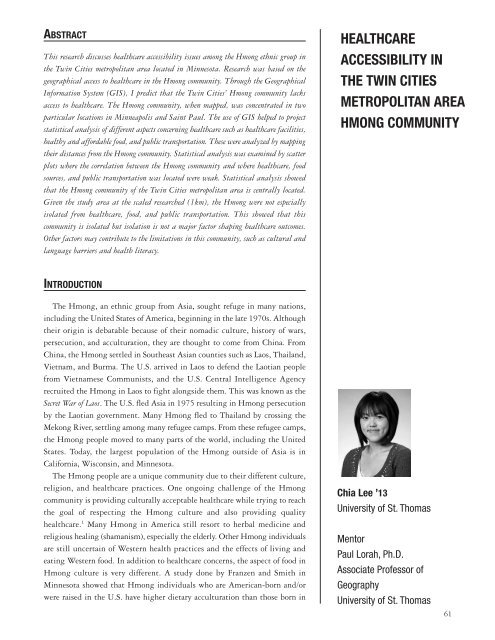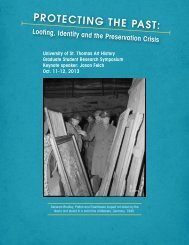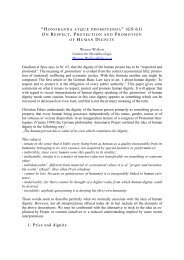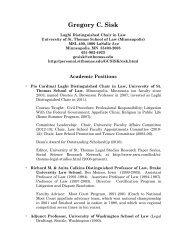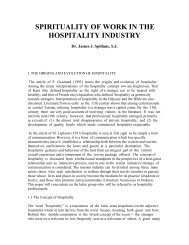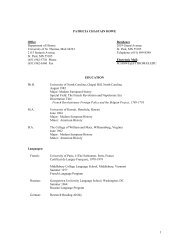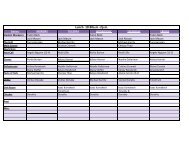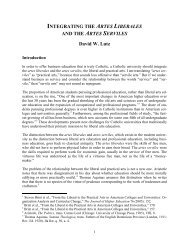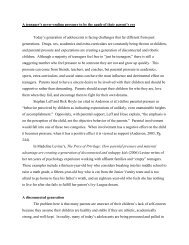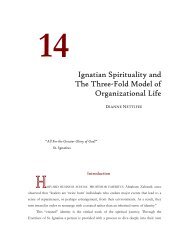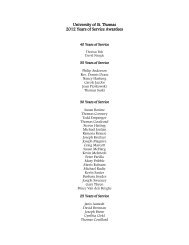dr. ronald e. mcnair acknowledgements - University of St. Thomas
dr. ronald e. mcnair acknowledgements - University of St. Thomas
dr. ronald e. mcnair acknowledgements - University of St. Thomas
Create successful ePaper yourself
Turn your PDF publications into a flip-book with our unique Google optimized e-Paper software.
ABSTRACT<br />
This research discusses healthcare accessibility issues among the Hmong ethnic group in<br />
the Twin Cities metropolitan area located in Minnesota. Research was based on the<br />
geographical access to healthcare in the Hmong community. Through the Geographical<br />
Information System (GIS), I predict that the Twin Cities’ Hmong community lacks<br />
access to healthcare. The Hmong community, when mapped, was concentrated in two<br />
particular locations in Minneapolis and Saint Paul. The use <strong>of</strong> GIS helped to project<br />
statistical analysis <strong>of</strong> different aspects concerning healthcare such as healthcare facilities,<br />
healthy and affordable food, and public transportation. These were analyzed by mapping<br />
their distances from the Hmong community. <strong>St</strong>atistical analysis was examined by scatter<br />
plots where the correlation between the Hmong community and where healthcare, food<br />
sources, and public transportation was located were weak. <strong>St</strong>atistical analysis showed<br />
that the Hmong community <strong>of</strong> the Twin Cities metropolitan area is centrally located.<br />
Given the study area at the scaled researched (1km), the Hmong were not especially<br />
isolated from healthcare, food, and public transportation. This showed that this<br />
community is isolated but isolation is not a major factor shaping healthcare outcomes.<br />
Other factors may contribute to the limitations in this community, such as cultural and<br />
language barriers and health literacy.<br />
INTRODUCTION<br />
The Hmong, an ethnic group from Asia, sought refuge in many nations,<br />
including the United <strong>St</strong>ates <strong>of</strong> America, beginning in the late 1970s. Although<br />
their origin is debatable because <strong>of</strong> their nomadic culture, history <strong>of</strong> wars,<br />
persecution, and acculturation, they are thought to come from China. From<br />
China, the Hmong settled in Southeast Asian counties such as Laos, Thailand,<br />
Vietnam, and Burma. The U.S. arrived in Laos to defend the Laotian people<br />
from Vietnamese Communists, and the U.S. Central Intelligence Agency<br />
recruited the Hmong in Laos to fight alongside them. This was known as the<br />
Secret War <strong>of</strong> Laos. The U.S. fled Asia in 1975 resulting in Hmong persecution<br />
by the Laotian government. Many Hmong fled to Thailand by crossing the<br />
Mekong River, settling among many refugee camps. From these refugee camps,<br />
the Hmong people moved to many parts <strong>of</strong> the world, including the United<br />
<strong>St</strong>ates. Today, the largest population <strong>of</strong> the Hmong outside <strong>of</strong> Asia is in<br />
California, Wisconsin, and Minnesota.<br />
The Hmong people are a unique community due to their different culture,<br />
religion, and healthcare practices. One ongoing challenge <strong>of</strong> the Hmong<br />
community is providing culturally acceptable healthcare while trying to reach<br />
the goal <strong>of</strong> respecting the Hmong culture and also providing quality<br />
healthcare. 1 Many Hmong in America still resort to herbal medicine and<br />
religious healing (shamanism), especially the elderly. Other Hmong individuals<br />
are still uncertain <strong>of</strong> Western health practices and the effects <strong>of</strong> living and<br />
eating Western food. In addition to healthcare concerns, the aspect <strong>of</strong> food in<br />
Hmong culture is very different. A study done by Franzen and Smith in<br />
Minnesota showed that Hmong individuals who are American-born and/or<br />
were raised in the U.S. have higher dietary acculturation than those born in<br />
HEALTHCARE<br />
ACCESSIBILITY IN<br />
THE TWIN CITIES<br />
METROPOLITAN AREA<br />
HMONG COMMUNITY<br />
Chia Lee ’13<br />
<strong>University</strong> <strong>of</strong> <strong>St</strong>. <strong>Thomas</strong><br />
Mentor<br />
Paul Lorah, Ph.D.<br />
Associate Pr<strong>of</strong>essor <strong>of</strong><br />
Geography<br />
<strong>University</strong> <strong>of</strong> <strong>St</strong>. <strong>Thomas</strong><br />
61


